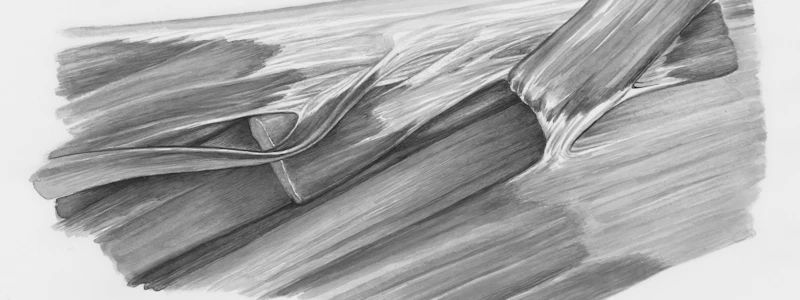Podcast
Questions and Answers
What is the acromial end?
What is the acromial end?
Specific part of the clavicle
What is the clavicle?
What is the clavicle?
Entire bone connecting the arm to the body
What is the coracoid process?
What is the coracoid process?
Specific part of the scapula
What is the glenoid cavity?
What is the glenoid cavity?
What is the sternal end?
What is the sternal end?
What is the spine?
What is the spine?
What is the acetabulum?
What is the acetabulum?
What is the anatomical neck?
What is the anatomical neck?
What is the capitate?
What is the capitate?
What is the capitulum?
What is the capitulum?
What are carpals?
What are carpals?
What is the coronoid fossa?
What is the coronoid fossa?
What is the coronoid process?
What is the coronoid process?
What is the deltoid tuberosity?
What is the deltoid tuberosity?
What are phalanges?
What are phalanges?
What is the greater trochanter?
What is the greater trochanter?
What is the greater tubercle?
What is the greater tubercle?
What is the hamate?
What is the hamate?
What is the head?
What is the head?
What is the iliac crest?
What is the iliac crest?
What is the ilium?
What is the ilium?
What is the ischial tuberosity?
What is the ischial tuberosity?
What is the ischium?
What is the ischium?
What is the lateral epicondyle?
What is the lateral epicondyle?
What is the lesser trochanter?
What is the lesser trochanter?
What is the lesser tubercle?
What is the lesser tubercle?
What is the lunate?
What is the lunate?
What is the medial epicondyle?
What is the medial epicondyle?
What are metacarpals?
What are metacarpals?
What is the obturator foramen?
What is the obturator foramen?
What is the olecranon process?
What is the olecranon process?
What is the pisiform?
What is the pisiform?
What is the pubic symphysis?
What is the pubic symphysis?
What is the pubis?
What is the pubis?
What is the radial notch?
What is the radial notch?
What is the radial tuberosity?
What is the radial tuberosity?
What is the scaphoid?
What is the scaphoid?
What is the trapezium?
What is the trapezium?
What is the trapezoid?
What is the trapezoid?
What is the triquetrum?
What is the triquetrum?
What is the trochlea?
What is the trochlea?
What is the trochlear notch?
What is the trochlear notch?
What is the tibial tuberosity?
What is the tibial tuberosity?
What is the olecranon fossa?
What is the olecranon fossa?
What is the ulna?
What is the ulna?
What is the radius?
What is the radius?
What is the femur?
What is the femur?
What is the shaft of the femur?
What is the shaft of the femur?
What is the patella?
What is the patella?
What is the tibia?
What is the tibia?
What is the fibula?
What is the fibula?
Flashcards are hidden until you start studying
Study Notes
Appendicular Skeleton Key Points
- Clavicle: Known as the collarbone; serves as a strut between the shoulder blade and the sternum.
- Scapula (Shoulder Blade): Features important parts including:
- Acromial End: Connects to the acromion on the scapula.
- Coracoid Process: A hook-like structure providing attachment for muscles and ligaments.
- Glenoid Cavity: A shallow socket that articulates with the head of the humerus.
- Spine: Prominent ridge on the posterior surface.
- Humerus: Upper arm bone with several key regions:
- Head: The rounded proximal end that fits into the glenoid cavity.
- Greater and Lesser Tubercle: Sites for muscle attachment.
- Capitulum: Articulates with the radius.
- Trochlea: Articulates with the ulna.
- Coronoid Fossa: Receives the coronoid process of the ulna during elbow flexion.
- Ulna: The medial bone of the forearm with specific features:
- Olecranon Process: The bony prominence of the elbow.
- Coronoid Process: Articulates with the humerus.
- Radial Notch: Articulates with the head of the radius.
- Radius: The lateral bone of the forearm known for:
- Radial Tuberosity: Site for biceps attachment.
- Styloid Process: Prominent bony projection at its distal end.
- Pelvic Bone: Composed of three fused bones:
- Ilium: Uppermost and largest part.
- Ischium: Lower part of the pelvis; features the ischial tuberosity.
- Pubis: Anterior portion; includes the pubic symphysis.
- Acetabulum: Socket for the head of the femur.
- Femur: Longest bone in the body with elements like:
- Head: Fits into the acetabulum.
- Greater and Lesser Trochanters: Muscle attachment sites.
- Medial and Lateral Condyles: Form knee joint with tibia.
- Tibia: The larger, weight-bearing bone of the lower leg; features include:
- Tibial Tuberosity: Site for patellar ligament attachment.
- Medial Malleolus: Bony prominence on inner ankle.
- Fibula: The thinner bone parallel to the tibia; provides stability to the ankle.
- Patella (Kneecap): A sesamoid bone that protects the knee joint.
- Carpals and Metacarpals: Bones of the wrist and hand; essential for dexterity.
- Tarsals and Metatarsals: Bones of the foot playing a crucial role in mobility and balance.
- Phalanges: Bones of fingers and toes; enable gripping and movement.
Carpal and Tarsal Bones
- Carpals:
- Include specific bones like Scaphoid, Lunate, Hamate, Pisiform, Trapezium, Trapezoid, and Triquetrum.
- Tarsals:
- Include Calcaneus, Cuboid, Medial Cuneiform, Lateral Cuneiform, and Talus.
General Notes
- The appendicular skeleton supports movement and stability for the limbs.
- Numerous bony landmarks serve as attachment points for muscles and ligaments, indicating the importance of these structures for mobility and strength.
Studying That Suits You
Use AI to generate personalized quizzes and flashcards to suit your learning preferences.




